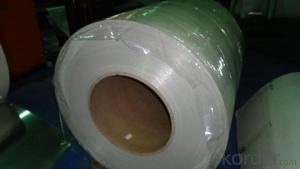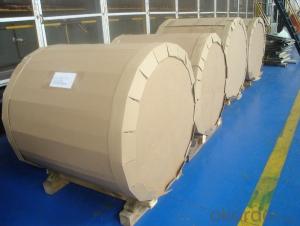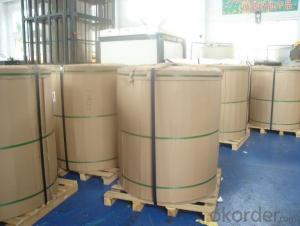Stucco Embossed and Coated Aluminum Coils for Refrigerator
- Loading Port:
- Shekou
- Payment Terms:
- TT OR LC
- Min Order Qty:
- 5 m.t.
- Supply Capability:
- 100000 m.t./month
OKorder Service Pledge
OKorder Financial Service
You Might Also Like
1.Structure of Stucco Embossed and Coated Aluminum Coils for Refrigerator
We professionally produce stucco embossed and coated aluminum coils, which are widely used in refrigerators, ice-boxes, cold storage, freezer, etc.
Stucco embossed and coated aluminum sheets look more beautiful and better at strength and rigidity than normal aluminum coils.
We normally use 3105, H44 as base coils. Specification of our stucco embossed and color coated aluminium coils: thickness 0.2-0.6mm, width less than 1600mm. As for coating, we normally use PVDF coating, PE coating, etc. We can adjust coating as per customers’ requirements.
2. Main Features of Stucco Embossed and Coated Aluminum Coils for Refrigerator
• Light Weight
• Good in strength and rigidity
• High Flatness
• Good Weathering
• Colorful
• Recycling
• Saving Energy
• Rust proof
3. Stucco Embossed and Coated Aluminum Coils for Refrigerator Images

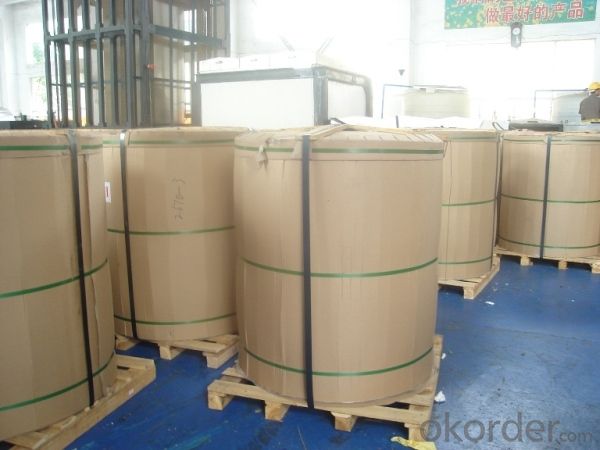
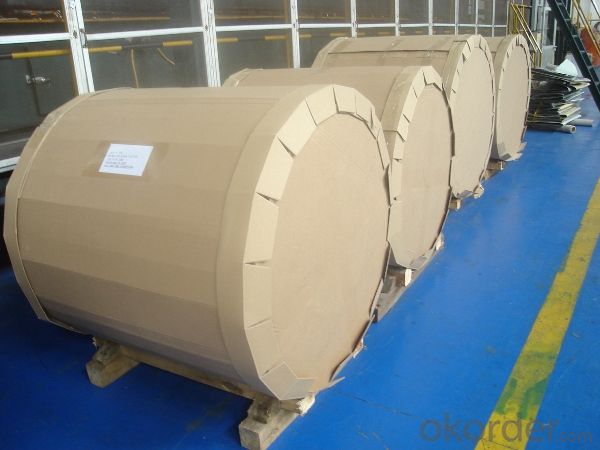
4. Specification of Stucco Embossed and Coated Aluminum Coils for Refrigerator
ALLOY | TEMPER | THICKNESS | WIDTH | COATING and COLOR |
3003, 3105, etc | H44, etc | 0.2-0.6mm | Less than1600mm | AS PER YOUR REQUIREMENTS |
5. FAQ
A.What about inspections to guarantee quality?
For each order, we will arrange strict inspection for raw materials, inspection during production and inspection for finished goods.
With requirement of customers, we also can arrange the third party inspection.
B.What about delivery?
We will put order in production schedule after order gets confirmed against copy of TT or L/C. Normally it takes about one month for production. Exact shipment schedule is different based on different sizes and quantity.
C.What is the MOQ?
5 tons for each size.
D. Where have you exported?
We have exported to many countries. Main markets include South East Asia, Middle East, North America, South America, etc.
- Q:What the glue of L solidified aluminum and fast acrylic plate, solid glue?
- Aluminum and acrylic adhesive, if you want to achieve high strength without any effect, can be bonded with KD-5603 trace glue, but this should be with the help of UV curing light curing, if there is no UV curing light, the sun is strong weather, stick in the sun after 30 minutes can be the bonding effect of glass panel; the specific effects can refer to the general glass coffee table with four Aluminum Alloy column, don't see any traces of adhesive;If you only need sticky sticks and low marks, you can choose N-906AB glue or KD-855 quick drying metal glue
- Q:Can aluminum sheets be anodized in different finishes?
- Yes, aluminum sheets can be anodized in different finishes. Anodizing is a process that creates a protective oxide layer on the surface of aluminum, and this layer can be colored or finished in various ways to achieve different aesthetic and functional results.
- Q:Are 101 aluminum sheets suitable for marine environments?
- No, 101 aluminum sheets are not suitable for marine environments as they lack sufficient corrosion resistance.
- Q:Are 101 aluminum sheets suitable for chemical storage tanks?
- No, 101 aluminum sheets are not suitable for chemical storage tanks. Aluminum, especially 101 aluminum, is not resistant to many chemicals and can react with them, leading to corrosion and potential leakage. Chemical storage tanks require materials that are specifically designed to withstand the corrosive nature of chemicals, such as stainless steel or certain types of plastics. It is essential to use materials that are chemically resistant and can ensure the safety and integrity of the stored chemicals.
- Q:What is the final concentration of aluminum cation?
- You have to be able to determine the number of moles of Al+3 that each solution contributes to the final solution: 1. aluminum chloride: AlCl3 Multiply the volume (in L) by the molarity to determine the number of moles of each compound dissolved in solution. 0.0431 L x 0.279 M = 0.0120 mol AlCl3 in solution When the AlCl3 in placed in the water, it dissociates to form the following ions: AlCl3 -- Al+3 + 3Cl- So for every one mole of AlCl3 placed in the water, one mole of aluminum ions will dissociate. Therefore, since we have 0.0120 mole of AlCl3 in the solution, that means that the aluminum chloride will contribute 0.0120 Al+3 ions to the final solution. 2. Aluminum sulfate: Al2(SO4)3 Multiply the volume (in L) by the molarity to determine the number of moles of each compound dissolved in solution. 0.0146 L x 0.464 M = 0.00677 mol Al2(SO4)3 in solution When the Al2(SO4)3 in placed in the water, it dissociates to form the following ions: Al2(SO4)3 -- 2Al+3 + 3(SO4)-2 So for every one mole of Al2(SO4)3 placed in the water, two mole of aluminum ions will dissociate. Use the mole ratios of the dissociation reaction to determine the number of moles of Al+3 ions that the aluminum sulfate contributes to the solution. 0.00677 mol Al2(SO4)3 x (2 mol Al+3 ions / 1 mol Al2(SO4)3) = 0.01354 mol Al+3 ions Therefore, the total number of Al+3 ions in solution is the sum: 0.01354 + 0.0120 = 0.02554 mol Al+3 ions The last piece of information needed to determine the concentration of the final solution is the volume of the final solution. Since the two volumes were mixed, the volume of the final solution will be the sum of the two solutions. 0.0431 L + 0.0146 L = 0.0577 L Therefore, to calculate molarity: Molarity = moles of solute / liters of solution Molarity = 0.02554 mol / 0.0577 L = 0.443 M Al+3
- Q:What are the different methods for perforating aluminum sheets?
- Aluminum sheets can be perforated using a variety of methods, each with its own advantages and applications. The most common methods include: 1. Punching: Traditional and cost-effective, punching involves using a punch and die set to create holes in the aluminum. This method is efficient for simple hole patterns and is commonly used in the automotive and construction industries. 2. Laser cutting: Precise and versatile, laser cutting uses a high-powered laser beam to vaporize or melt the metal, creating intricate and complex hole patterns. It is highly accurate and fast, suitable for decorative and functional perforations. 3. Waterjet cutting: Another popular method, waterjet cutting uses a jet of high-pressure water mixed with abrasive materials to erode the metal and create holes. It is known for its ability to cut through thick aluminum sheets and produce clean edges. Commonly used in aerospace and architecture. 4. Rotary perforating: This method involves using a rotating cylindrical tool with sharp blades or teeth to perforate the aluminum. It is ideal for continuous perforations or patterns with curved or irregular hole shapes. Commonly used in filtration systems and acoustic panels. 5. Pressing: Also known as embossing or stamping, pressing involves pressing a patterned die into the aluminum to create raised or sunken areas. These areas can act as perforations, providing aesthetic appeal or functional applications. Hydraulic or mechanical presses are used, commonly in architecture and interior design. It's important to consider factors such as desired hole pattern, material thickness, production volume, and budget when choosing a perforation method. Consulting with a perforation specialist can help determine the most suitable method for a specific application.
- Q:Can aluminum sheets be used for chemical reactors?
- Yes, aluminum sheets can be used for chemical reactors in certain applications. Aluminum is known for its excellent corrosion resistance, which makes it suitable for various chemical reactions. However, it is important to consider the type of chemicals being used and their potential reactivity with aluminum. Aluminum may not be suitable for highly acidic or alkaline environments as it can react and corrode. Additionally, aluminum may not be appropriate for reactions involving certain gases or high temperatures. In such cases, alternative materials like stainless steel or glass-lined reactors may be more suitable.
- Q:Can 101 aluminum sheets be used in electrical or electronic components?
- Yes, 101 aluminum sheets can be used in electrical or electronic components. Aluminum is a versatile metal that possesses excellent electrical conductivity and is widely used in various electrical and electronic applications. It is commonly used as a conductor in power transmission lines, electrical cables, and wiring. Additionally, aluminum sheets can be used in the manufacturing of electronic components such as heat sinks, circuit boards, and enclosures due to their lightweight, corrosion-resistant, and thermally conductive properties. However, it is important to note that the specific grade and alloy of aluminum, as well as other factors such as thickness and surface treatment, may also influence its suitability for certain electrical or electronic applications.
- Q:Are aluminum sheets suitable for thermal insulation?
- No, aluminum sheets are not suitable for thermal insulation as they have high thermal conductivity, meaning they are not effective in preventing heat transfer.
- Q:what's the difference between aluminum sheet detergent and central air-condition detergent?
- Central air condition cleaning includes air-cooled condenser cleaning and water-cooling condenser cleaning, if it’s air-cooled condenser cleaning, you can use aluminum sheet detergent.
1. Manufacturer Overview |
|
|---|---|
| Location | |
| Year Established | |
| Annual Output Value | |
| Main Markets | |
| Company Certifications | |
2. Manufacturer Certificates |
|
|---|---|
| a) Certification Name | |
| Range | |
| Reference | |
| Validity Period | |
3. Manufacturer Capability |
|
|---|---|
| a)Trade Capacity | |
| Nearest Port | |
| Export Percentage | |
| No.of Employees in Trade Department | |
| Language Spoken: | |
| b)Factory Information | |
| Factory Size: | |
| No. of Production Lines | |
| Contract Manufacturing | |
| Product Price Range | |
Send your message to us
Stucco Embossed and Coated Aluminum Coils for Refrigerator
- Loading Port:
- Shekou
- Payment Terms:
- TT OR LC
- Min Order Qty:
- 5 m.t.
- Supply Capability:
- 100000 m.t./month
OKorder Service Pledge
OKorder Financial Service
Similar products
New products
Hot products
Hot Searches
Related keywords
